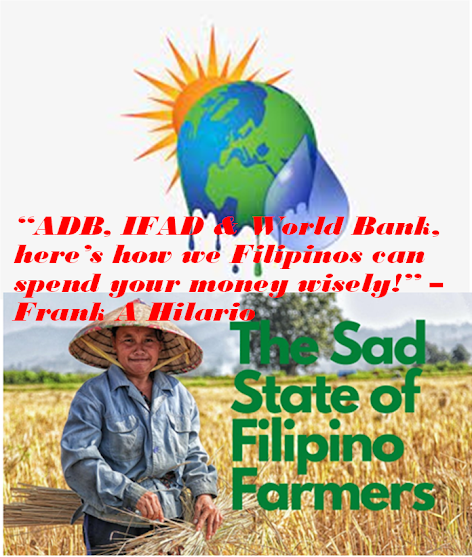ADB, IFAD And World Bank – Should Not Your US$ Millions & Millions Of Funds For PH Instead Addressed To Solve Farmer Poverty And Simultaneously Resolve Climate Change!?
Thank you, ADB, IFAD and World Bank for your billion-dollar agriculture projects for the Philippines! Today, Friday, 10 Feb 2023, in one quick digital search, I count a total of US$1.6 billion. As an agriculturist (UP Los Baños 1965, BS Agriculture major in Agricultural Education) focused on “Communication for Development” (ComDev), my original 40-year-old concept – I will now scrutinize your projects as they relate to National Development via Agriculture.
I am now looking at the IFAD, ADB, World
Bank projects in the Philippines for agriculture development:
ADB has a “Competitive and Inclusive
Agriculture Development Program, Subprogram 1 (RRP PHI 53353)” (“Risk Assessment And Risk Management Plan” in
pdf, ADB, adb.org).
The
financing support for PH efforts in agricultural development, from my quick
search, has IFAD with US$845 million, ADB with US$500 million, and World Bank
with US$280 million (PRDP).
ADB:
The
policy-based loan (PBL) is aligned with the Philippine Development Plan, 2017−2022 and the Asian Development Bank (ADB) country partnership strategy
for the Philippines, 2018–2023, which emphasizes inclusive growth and local
economic development. The Philippine Development Plan identified the
agriculture sector as instrumental in reducing poverty, particularly in rural
areas.
The World Bank says (09 Sept 2020, “Vibrant
Agriculture is Key to Faster Recovery and Poverty Reduction,” World Bank, worldbank.org):
Several projects are in the pipeline to
help raise agricultural productivity, resiliency and access to markets of
farmers and fisherfolk in selected ancestral domains in Mindanao.
From the Department
of Agriculture, the report is this: “Basically, around 5.5 million
farmers and 5.6 million fishers are poor” in the Philippines (14 Jan 2021, “DA-SAAD’s
Contribution To Philippine’s Poverty Reduction: An Analysis,” saad.da.gov.ph).
From reliefweb
(reliefweb.int),
the report is this: “Multiple indices rank the Philippines as one of the
countries most affected by extreme climate events. The country has experienced
highly destructive typhoons almost annually for the past 10 years. Annual
losses from typhoons have been estimated at 1.2 percent of GDP.”
Nota bene:
ADB projects: “The agriculture sector as
instrumental in reducing poverty, particularly in the rural areas.” IFAD
projects: “Aim to improve access to markets, technology and rural financial
services.” World Bank projects: “To raise agricultural productivity, resiliency
and access to markets of farmers and fisherfolk.”
Sadly, I note that those billion-dollar projects do not address
directly the poverty of millions of Filipino farmers!
Necessarily, I must note that the ADB, IFAD and World Bank are not
minding the Philippines continuing to practice Chemical
Agriculture (CA) – which is continuing to generate greenhouse gases
(GHGs) that generate Climate Change.
I wish ADB, IFAD and World Bank instead help solve the poverty of millions
of our farmers by also funding ComDev projects encouraging Regenerative Agriculture and discontinuing
prevailing methods of Chemical
Agriculture – chemical fertilizers and pesticides. Regenerative projects
will solve Farmer Poverty and simultaneously
help resolve Climate Change! How?
The total costs of farming will go down much, and the GHGs will disappear!@517
(“Dripping World” from google.com),
“Sad State” from youtube.com)




Comments
Post a Comment